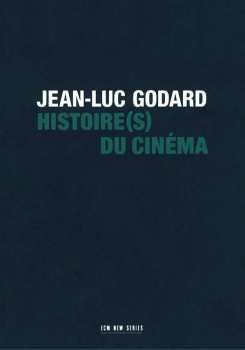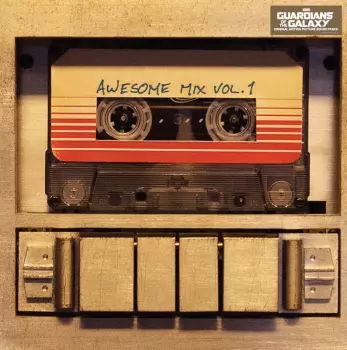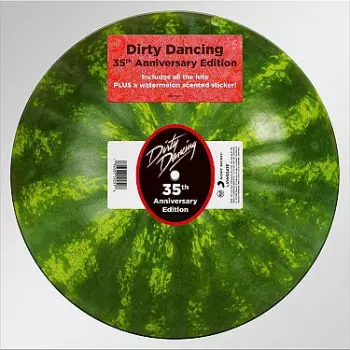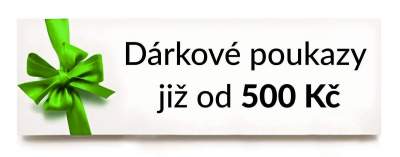ECMNewSeries
26. September 2000
Europe
"From Hollywood to the Third World, from the mainstream to the avant-garde, Godard's name is perhaps the only one that appears wherever film is discussed or produced. And yet he lives a life as far removed from the conventional image of the filmmaker as one can imagine. For more than ten years he has lived in the small Swiss village of Rolle, ha...
Condition
New
Availability
Price
137,99 €
154,99 €
Free CZ delivery
Availability
Details
| Title | Histoires Du Cinema |
| Artist | Various |
| Format | 5x CD |
| Labels | ECMNewSeries |
| Country of issue | Europe |
| Date of publication | 26. September 2000 |
| First released | 1999 |
| EAN | 0028946515129 |
| Product ID | 221606 |
"From Hollywood to the Third World, from the mainstream to the avant-garde, Godard's name is perhaps the only one that appears wherever film is discussed or produced. And yet he lives a life as far removed from the conventional image of the filmmaker as one can imagine. For more than ten years he has lived in the small Swiss village of Rolle, halfway between Lausanne and Geneva... As a shaman, he alternates almost complete isolation from the world with sudden bursts of interest. What allows him to escape from his intense privacy is his obsession with the sights and sounds of film. It is this intensity of Godard's devotion to cinema that makes his life more than just a record of an extraordinary personality, but inevitably a history of European culture since the Second World War."-Colin Miles McCabe Jean-Luc Godard's Histoires du cinéma is undoubtedly a work of immense scope and defies easy definition. A wide-ranging essay on cinema through film. A history of film and history interpreted by film. A tribute and critique. An anecdotal autobiography shot through with Godard's encyclopedic wit, expanding the idiom established by JLG par JLG. An epic - and non-linear - poem. A free associative essay. A vast multi-layered musical composition. Histoire(s) du cinéma is all of these. Above all, it is a work created by a man who loves and is fascinated by the world of cinema. For the American film critic Jonathan Rosenbaum, Godard's video series represents the pinnacle of 20th century filmmaking and is a work of "immense significance": "Just as Finnegans Wake, the work of art to which Histoire(s) du cinéma seems most comparable, situates itself in a certain theoretical phase after the end of the English language as we know it, Godard's magnum opus similarly projects itself into the future to ask: 'What was film?'" French journalist Antoine de Baecque sees parallels in Histoire(s) du cinéma with another revolutionary moment in art history: 'Somehow it reminds me of Cubism. 1907 and 'Les Demoiselles d'Avignon'. Picasso would not reveal his manifesto as a painter until twenty years later, and yet this work is talked about as something absolutely fundamental. To overlook it is to overlook the beginning of the century. The same can be said of Proust or Joyce. As for Godard's Histoire(s) du cinéma, anyone who has not seen it has not understood our times. They would have missed the end of the century." Or, as JLG remarks towards the end of the work: as one century slowly dissolves into the next, a few individuals transform old means of survival into new means of survival We call these art The only thing that survives an epoch as such is the art form it has created for itself No activity can become art until its epoch is over later this art disappears Histoire(s) du cinéma - as a television series / video essay - was produced for Canal+, ARTE and Gaumont between 1988 and 1998. The work is divided into four chapters in two parts. Of these four chapters, the first was broadcast simultaneously on five European channels, while the other three were screened at film festivals. In 1997, the series was screened as part of an installation at the Documenta X interdisciplinary art festival in Kassel, Germany. The Museum of Modern Art in New York screened each episode as it became available. "Exile from the Land of Images" The edition now published by ECM New Series is the first international release of this important work and takes the form of a box set containing five CDs with the complete audio track Histoire(s) du cinéma and four books containing the full text of Godard's narrative with German and English translations. The selection of music Godard included reflects JLG's ongoing collaboration with Manfred Eicher, founder and producer of ECM. "Manfred began our relationship," the director noted, "by sending me music. And after listening to it, I wrote to him and asked him to send me more recordings. I had the feeling that we were more or less in the same territory: he with sounds, me with images. The music he sent me made me feel like we were making a film, and I started to imagine different things through that kind of music. In fact, some of those recordings led me to Nouvelle Vague and later to other films... Often the sounds gave us the feeling of being orphaned from the images, or being driven out of the land of images... it was as if we were hearing music from films that didn't exist." ECM focuses on the sound of Histoire(s) and takes JLG at his word. When introducing Nouvelle Vague nine years ago, he made the remark, "If you see a Guitry film without sound, it will be the same. My film without sound will be better. But if you 'see' the soundtrack without the picture, it will have an even greater impact." The release of Nouvelle Vague by ECM in 1997 in the form of two compact discs brought a reassessment of Godard's sense of sound. To quote Cahiers du Cinéma, "The soundtrack is spectacular. The blending of different forms of music, voices and sounds is one of the most remarkable ever heard. We are invited to take part in an unprecedented experience. We are invited to immerse ourselves in a world of musical découpage and literary montages... The listener hears interruptions, continuations, distant mixing, montage effects, echoes, repetitions, breaths, punctuations, rhythms, inflections. Montage, mixing. Shock, fluidity... Finally, there is clear proof for those who perhaps had suspected that Godard was not a composer in the full sense of the word." Gramophone also recognized the craftsmanship and fluidity of Godard's sound construction: "Freed from visual distractions, the music takes on a programmatic role, often subverting the listener's instinctive preference for music, dialogue or sound: the screech of a car mingles with the phrase of a cello; a certain melody of a bandoneon floats with almost condescending grace over dialogue and sound." The American magazine Jazziz was one of many to endorse the intuitive flow of the music, its "mysterious beauty and haunting power. Its boldness is akin to the exploratory visions of the best of jazz." The music underscores the meaning of the text or offers a counterpoint, sometimes ironically. There are sounds of sea and wind, bird calls and distant cries. Gunshots and the machine-gun clatter of the author's electric typewriter... all are included in the protean, shifting stream of Histoire(s). ("Emotions are evoked," as Claire Bartoli noted, "by the very nature of sound.") Other voices offer sidemen: André Malraux, Ezra Pound, Paul Celan. In the pantheon of JLG's cinematic greats, Hitchcock occupies a special place. "I included Hitchcock [in Histoire(s)] because he was truly the master of the universe at a certain epoch. More than Hitler, more than Napoleon. He controlled the audience, which no one else had. The public was controlled by poetry. And Hitchock was a poet on a universal level, the only maudit poet who had a huge success; Rilke wasn't, Rimbaud wasn't. He was a maudit poet for everybody." Complete audio recording of the Histoire(s) du cinéma video series narrated by Jean-Luc Godard, featuring Juliette Binoche, Julie Delpy, Anne-Marie Miéville, and the voices of André Malraux, Ezra Pound, Paul Celan, and others. Godard's montage also includes music by Paul Hindemith, Arvo Pärt, Ludwig van Beethoven, Guy Kancheli, Béla Bartók, Franz Schubert, Igor Stravinsky, Johann Sebastian Bach, John Coltrane, Leonard Cohen, Otis Redding, Dmitri Shostakovich, Anton Webern, Dino Saluzzi, David Darling, Ketil Bjørnstad and many others. Arranged and produced for the ECM New Series by Manfred Eicher. Images from Jean-Luc Godard's Histoire(s) du cinéma. The soundtrack for this release was remixed by François Musy. A 5-CD set in outsize format with four extensive trilingual text books containing the complete text of JLG's narration, an interview with Godard by Jonathan Rosenbaum, and over 300 stills from Histoire(s) du cinéma.
Album spans genres Rock, Pop, Stage & Screen, Pop Rock and Soundtrack.
| Please note that the dimensions may vary slightly from piece to piece | |||||
Men's |
|||||
| T-SHIRTS | LONG SLEEVE T-SHIRTS | ||||
| SIZE | CHEST CIRCUMFERENCE (CM) | SIZE | CHEST CIRCUMFERENCE (CM) | ||
| XXL | 122 | XXL | 124.5 - 127 | ||
| XL | 117 | XL | 122 | ||
| L | 106.5 | L | 112 | ||
| M | 96.5 | M | 101.5 | ||
| S | 91.5 | S | 94 | ||
| HOODIES | SWEATSHIRTS WITH ZIP | ||||
| SIZE | CHEST CIRCUMFERENCE (CM) | SIZE | CHEST CIRCUMFERENCE (CM) | ||
| XXL | 127 | XXL | 119.5 - 124.5 | ||
| XL | 122 | XL | 112 - 117 | ||
| L | 112 | L | 104 - 109 | ||
| M | 101.5 | M | 96.5 - 101.5 | ||
| S | 91.5 | S | 89 - 94 | ||
Women's |
|||||
| T-SHIRTS | SKINNY FIT T-SHIRTS | ||||
| SIZE | CHEST CIRCUMFERENCE (CM) | SIZE | CHEST CIRCUMFERENCE (CM) | ||
| XL | 91.5 - 96.5 | L / XL | 91.5 - 96.5 | ||
| L | 86 - 91.5 | S / M | 81 - 86 | ||
| M | 81 - 86 | ONE SIZE | 81 approx. | ||
| S | 76 - 81 | ||||
| VESTS | SWEATSHIRTS WITH ZIP | ||||
| SIZE | CHEST CIRCUMFERENCE (CM) | SIZE | CHEST CIRCUMFERENCE (CM) | ||
| XL | 91.5 - 94 | L | 96.5 - 101.5 | ||
| L | 86 - 91.5 | M | 91.5 - 96.5 | ||
| M | 81 - 86 | S | 81 - 86 | ||
| S | 76 - 81 | ||||
We have everything!
Over
177 000
LP a
283 000
CD
on offer
Loyalty discount up to 5%
For registered customers
Have control!
The most advanced tracking
of availability and orders









